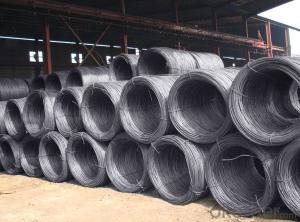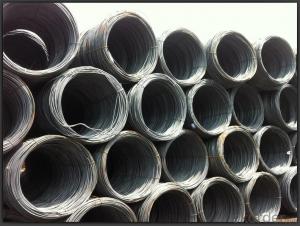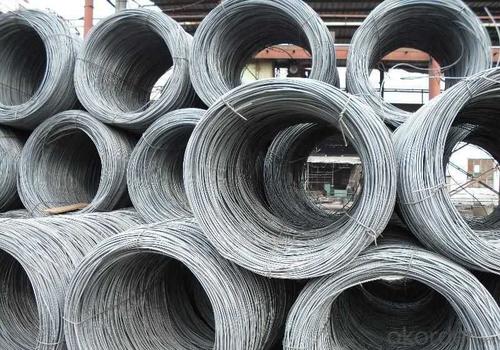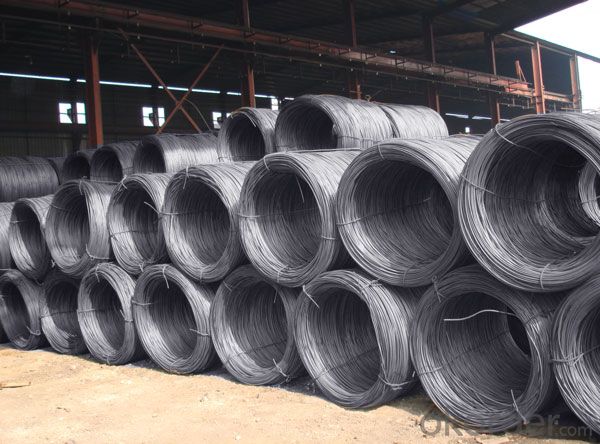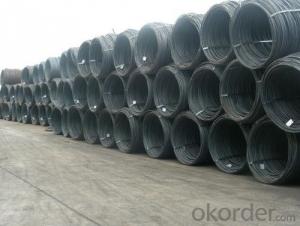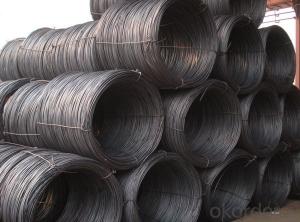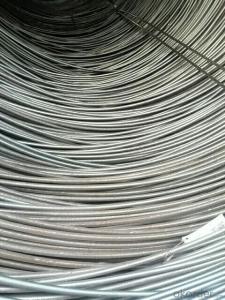hot rolled wire rod SAE1006-1018B 5.5MM-14MM
- Loading Port:
- Tianjin
- Payment Terms:
- TT OR LC
- Min Order Qty:
- 25 m.t.
- Supply Capability:
- 20000000 m.t./month
OKorder Service Pledge
OKorder Financial Service
You Might Also Like
WIRE ROD Details:
| Minimum Order Quantity: | m.t. | Unit: | m.t. | Loading Port: | |
| Supply Ability: | m.t./month | Payment Terms: | TT OR LC |
Product Description:
Steel Grade: Q195 Standard: ASTM, GB
Diameter: 5.5mm, 6.5mm, 7mm,8mm,9mm,10mm,12mm,14mm
6.5mm can be drawing into 2mm/8.0mm can be drawing into 3mm
Type: Drawn Wire in Coil, each coil weight about 2MT
Brand Name: N-RIVER Place of Origin: Hebei, China
Chemical Composition:
Please kindly find our chemistry of our material based on Q195 as below for your information
Trademark | Rank | Chemical composition (quality score) % | |||||
C | Si | Mn | S | P | |||
| ≤ |
| ≤ | ≤ | |||
Q195 |
| 0.06-0.12 | 0.30 | 0.25 | 0.050 | 0.045 | |
Trademark | Rank | Pulling Test | |||||
Bend PointΔs/Mpa | Tensile Strength | Elongation Ratioδ5% | |||||
Thickness (Diameter) /MM | Thickness (Diameter) /MM | ||||||
≤16 | 16-40 | ≤16 | 16-40 | ||||
≥ | ≥ | ||||||
Q195 |
| 195 | 185 | 315-390 | 33 | 32 | |
Usage and Applications of Wire Rod Q195:
After hot-rolled the products shaped into coil and delivery as finished product, including round, square, rectangular, hexagonal and so on. Since most of the products are round, it is generally called wire rod. Carbon steel wire rod is widely used in construction and manufacturing. Carbon steel wire rod is mainly used for reinforcement of reinforced concrete and welded structure or reprocessed (roberts , nail, etc.) materials, especially used to produce wire drawing, welding electrode, nails, spring, electronic, precise machinery parts and so on
- Q: How is steel wire rod used in the manufacturing of wire forms for recreational equipment?
- Steel wire rod is an essential component used in the manufacturing of wire forms for recreational equipment. This type of wire has high tensile strength, durability, and flexibility, making it ideal for creating various wire forms that are commonly found in recreational equipment such as playground structures, sports equipment, and outdoor fixtures. In the production of wire forms for recreational equipment, steel wire rod is initially processed through a series of steps to ensure its quality and desired properties. The wire rod is first drawn through a series of dies to reduce its diameter and increase its length. This process, known as wire drawing, results in a wire that is consistent in size and has improved tensile strength. Once the steel wire rod has been drawn, it can be further manipulated to create different wire forms. For instance, it can be bent, cut, or welded to form intricate shapes that are required for specific recreational equipment. The flexibility of steel wire rod allows for the production of various wire forms, such as loops, hooks, rings, and coils, which are crucial components in different recreational equipment. These wire forms made from steel wire rod are then incorporated into the manufacturing process of recreational equipment. For example, in playground structures, steel wire rod is used to create strong and secure loops or hooks that connect different components together, providing stability and strength to the overall structure. In sports equipment, steel wire rod is often used to form durable and resilient frames for products such as basketball hoops, soccer goals, or fencing materials. Additionally, steel wire rod is used in the manufacturing of wire forms for outdoor fixtures like swings, hammocks, and bike racks. These wire forms are designed to withstand constant usage, exposure to harsh weather conditions, and heavy loads. Steel wire rod ensures that these wire forms are strong, reliable, and long-lasting, ensuring the safety and enjoyment of users. In conclusion, steel wire rod plays a vital role in the manufacturing of wire forms for recreational equipment. Its high tensile strength, durability, and flexibility make it a preferred choice in creating various wire forms that serve as essential components in recreational equipment, providing stability, strength, and safety to users.
- Q: What are the common finishing methods for steel wire rod?
- The common finishing methods for steel wire rod include drawing, galvanizing, coating, heat treatment, and surface polishing.
- Q: What are the different types of wire rods for reinforcement made from steel wire rod?
- There are several different types of wire rods for reinforcement that are made from steel wire rod. These include: 1. Mild Steel Wire Rods: These wire rods are made from low carbon steel and are the most commonly used type of wire rod for reinforcement. They provide good strength and durability, making them suitable for a wide range of applications. 2. High Tensile Steel Wire Rods: These wire rods are made from high carbon steel and are specifically designed to provide greater strength and resistance to tension. They are often used in applications where a higher level of reinforcement is required, such as in construction projects or in the manufacturing of heavy machinery. 3. Stainless Steel Wire Rods: These wire rods are made from stainless steel, which is a highly corrosion-resistant material. They are commonly used in environments where there is a risk of corrosion, such as in coastal areas or in chemical processing plants. 4. Galvanized Steel Wire Rods: These wire rods are coated with a layer of zinc to provide protection against corrosion. They are commonly used in outdoor applications or in areas with high levels of moisture, as the zinc coating helps to prevent rust and deterioration. 5. Copper-Clad Steel Wire Rods: These wire rods are made by cladding a layer of copper onto a steel core. They combine the strength and durability of steel with the excellent electrical conductivity of copper, making them ideal for applications where both properties are required, such as in electrical wiring or grounding systems. Overall, the different types of wire rods for reinforcement made from steel wire rod offer a variety of properties and characteristics to suit different applications and environments.
- Q: How is the weldability of steel wire rod evaluated?
- The weldability of steel wire rod is typically evaluated through various tests and assessments such as bend tests, tensile tests, and Charpy impact tests. These tests help determine the weldability characteristics of the steel wire rod, including its ability to withstand welding processes without developing defects or cracks. Additionally, the chemical composition, microstructure, and mechanical properties of the steel wire rod are also considered in evaluating its weldability.
- Q: How are steel wire rods used in the production of welding electrodes?
- Steel wire rods are used in the production of welding electrodes as they serve as the core material for the electrode. The steel wire rods are manufactured with specific chemical composition and mechanical properties to ensure strength and durability. They are then further processed to form the electrode's outer coating, which provides additional properties such as arc stability, slag removal, and alloying elements. Overall, steel wire rods are essential for the production of welding electrodes as they form the backbone of the electrode, enabling efficient and effective welding operations.
- Q: How is steel wire rod used in the manufacturing of wire mesh panels?
- Steel wire rod is a crucial component in the manufacturing of wire mesh panels as it serves as the raw material. The wire rod is first drawn through a series of dies to reduce its diameter and increase its length, resulting in a thinner and longer wire. These wires are then woven or welded together to form the wire mesh panels, which find application in various industries such as construction, agriculture, and manufacturing.
- Q: What are the different grain size measurement methods for steel wire rod?
- There are several different grain size measurement methods commonly used for steel wire rod. These methods provide important information about the microstructure and mechanical properties of the steel. One widely used method is the ASTM E112 standard, which involves the use of a microscope to measure the average grain size. This method requires preparing a metallographic sample, polishing it to a mirror-like finish, and etching it to reveal the grain boundaries. The sample is then examined under a microscope, and the grain boundaries are traced and counted to determine the average grain size. Another method is the Sieve Analysis method, which is commonly used for determining the grain size distribution in steel wire rod. In this method, a representative sample of the wire rod is sieved through a series of progressively smaller mesh sieves. The weight of material retained on each sieve is measured, and the grain size distribution is determined based on the percentage of material retained on each sieve. The Laser Diffraction method is another commonly used technique for measuring grain size in steel wire rod. In this method, a laser beam is directed through a suspension of the wire rod particles, and the scattering pattern is measured. The size of the particles can be determined based on the diffraction pattern, allowing for the calculation of the grain size distribution. Other methods include the Electron Backscatter Diffraction (EBSD) method, which uses an electron microscope to determine the crystallographic orientation and grain boundaries in the wire rod, and the X-ray Diffraction (XRD) method, which measures the angle of diffraction of X-rays to determine the crystallographic structure and grain size. Each of these grain size measurement methods has its advantages and limitations, and the choice of method depends on factors such as the desired level of accuracy, the type of steel wire rod being analyzed, and the available equipment and expertise.
- Q: What are the main factors influencing the choice of steel wire rod order invoicing process?
- The efficiency, accuracy, and customer preference are the main factors that impact the choice of steel wire rod order invoicing process. In order to process and generate invoices for steel wire rod orders, it is crucial for companies in the steel industry to prioritize efficiency. This means considering the speed and automation of the invoicing process to ensure timely delivery of invoices to customers. Utilizing software or systems that can automatically generate invoices based on order details can reduce the need for manual data entry and minimize the chances of errors or delays. Accuracy is also of utmost importance as it ensures that the invoices accurately reflect the quantities, prices, and terms agreed upon in the order. To achieve accuracy, the invoicing process should incorporate mechanisms to verify and cross-check the order details. Customer preference is another significant factor in determining the invoicing process. Different customers may have varying requirements or preferences for receiving and processing invoices. Some may prefer digital invoices sent via email or electronic data interchange (EDI), while others may still prefer physical copies sent through mail or courier. To ensure customer satisfaction and facilitate smooth payment processing, it is essential for companies to understand and accommodate these preferences. Furthermore, factors like regulatory compliance, data security, and integration with existing systems may also influence the choice of steel wire rod order invoicing process. Companies must adhere to legal and regulatory requirements related to invoicing and prioritize the security and privacy of customer data. Integrating with existing systems, such as enterprise resource planning (ERP) or customer relationship management (CRM) software, can streamline the invoicing process and enhance overall efficiency. To summarize, the choice of steel wire rod order invoicing process is influenced by efficiency, accuracy, and customer preference. Companies must consider these factors and select a process that optimizes these aspects while ensuring compliance and data security.
- Q: How does the ductility of steel wire rod vary with different heat treatment processes?
- The ductility of steel wire rod can vary with different heat treatment processes. Heat treatment processes such as annealing and tempering can improve the ductility of steel wire rod by reducing its hardness and increasing its flexibility. On the other hand, processes like quenching and martempering can decrease the ductility of steel wire rod by increasing its hardness and brittleness. Therefore, the specific heat treatment process chosen can significantly affect the ductility of steel wire rod.
- Q: How is steel wire rod used in the manufacturing of wire forms for garage doors?
- The manufacturing process of wire forms for garage doors heavily relies on steel wire rod. This essential component acts as the primary material for producing sturdy and long-lasting wires used in the construction of garage doors. To begin with, the selection of steel wire rod is a meticulous process that considers specific qualities like strength, flexibility, and resistance to corrosion. These characteristics ensure that the wires created from the rod can endure the daily tension and stress experienced by garage doors. The manufacturing process commences with the introduction of the steel wire rod into a wire drawing machine. This machine progressively elongates the rod, decreasing its diameter while increasing its length. By repeating this process, the wire is shaped to the desired diameter and length suitable for wire forms. Once the wire has been drawn, it is then molded into various forms crucial for the proper functioning of the garage door. For example, it can be bent or coiled to form springs that provide the necessary counterbalance for the door's weight. These springs are vital to ensure the smooth operation and correct balance of the garage door. Moreover, the wire can also be shaped into cables or tracks that guide the movement of the garage door along its designated path. These cables and tracks guarantee a secure and seamless movement of the door, minimizing any potential damage or accidents. Additionally, steel wire rod is utilized in the creation of reinforcement bars, which add strength and stability to different components of the garage door. These reinforcement bars are strategically placed in areas prone to stress and strain, such as hinges and tracks, to prevent deformation or failure. In conclusion, steel wire rod plays an indispensable role in manufacturing wire forms for garage doors. Its strength, flexibility, and resistance to corrosion make it the ideal material for producing wires capable of meeting the demanding requirements of garage door operation.
Send your message to us
hot rolled wire rod SAE1006-1018B 5.5MM-14MM
- Loading Port:
- Tianjin
- Payment Terms:
- TT OR LC
- Min Order Qty:
- 25 m.t.
- Supply Capability:
- 20000000 m.t./month
OKorder Service Pledge
OKorder Financial Service
Similar products
Hot products
Hot Searches
Related keywords

